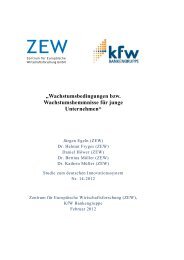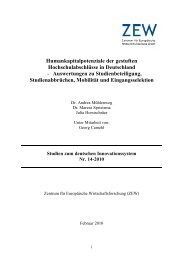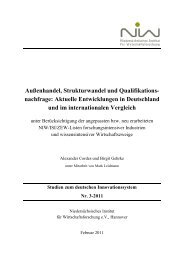research, innovation and technological performance in germany
research, innovation and technological performance in germany
research, innovation and technological performance in germany
You also want an ePaper? Increase the reach of your titles
YUMPU automatically turns print PDFs into web optimized ePapers that Google loves.
42<br />
EFI REPORT<br />
2010<br />
ufactur<strong>in</strong>g, chemistry, <strong>and</strong> mechanical eng<strong>in</strong>eer<strong>in</strong>g<br />
make frequent use of the latest <strong>technological</strong> advances.<br />
However, they ma<strong>in</strong>ly use their <strong>research</strong><br />
results <strong>in</strong>ternally. Companies from areas of cutt<strong>in</strong>g-edge<br />
technology, e.g. pharmaceuticals <strong>and</strong> biotechnology,<br />
network <strong>and</strong> Internet technology tend<br />
to stimulate the <strong><strong>in</strong>novation</strong> process more, but they<br />
are less well represented <strong>in</strong> Germany.<br />
Greater efforts are needed to improve knowledge<br />
<strong>and</strong> technology transfer<br />
Increased efforts are needed both by <strong>in</strong>stitutions<br />
carry<strong>in</strong>g out basic <strong>research</strong> <strong>and</strong> <strong>in</strong> companies <strong>in</strong><br />
order to overcome the regrettable deficits <strong>in</strong> implementation.<br />
The private sector must open up promis<strong>in</strong>g<br />
fields, which are compatible with the specific<br />
strengths of German <strong>research</strong>. These should be<br />
promoted by <strong>in</strong>creased third-party fund<strong>in</strong>g, the establishment<br />
of new foundations <strong>and</strong> <strong>in</strong>stitutes, <strong>and</strong><br />
new models for cooperation between companies <strong>and</strong><br />
universities or <strong>research</strong> <strong>in</strong>stitutions. There are grow<strong>in</strong>g<br />
numbers of examples of this, e.g. at the LMU<br />
Munich, RWTH Aachen, <strong>and</strong> the universities <strong>in</strong><br />
Darmstadt, Heidelberg und Oldenburg. 62<br />
Knowledge <strong>and</strong> technology transfer works very<br />
well where manufactur<strong>in</strong>g companies <strong>and</strong> public<br />
<strong>research</strong> <strong>in</strong>stitutions are work<strong>in</strong>g <strong>in</strong> complementary<br />
fields <strong>and</strong> can exchange <strong>in</strong>formation on the basis<br />
of well-established personal contacts. However,<br />
all too many <strong>research</strong> projects <strong>and</strong> <strong>in</strong>stitutes f<strong>in</strong>d<br />
no potential <strong>in</strong>dustrial partners <strong>in</strong> their vic<strong>in</strong>ity <strong>and</strong><br />
prefer to draw on the attractive fund<strong>in</strong>g from public<br />
sector sources. In addition, these <strong>in</strong>stitutes do<br />
not have the necessary <strong>in</strong>centive mechanisms for<br />
cooperation with the private sector, or they lack<br />
sufficient experience. In particular the <strong>in</strong>stitutes of<br />
the Fraunhofer Society <strong>and</strong> the universities cooperate<br />
closely with the private sector.<br />
For non-university <strong>research</strong> <strong>in</strong>stitutions, the ability<br />
<strong>and</strong> will<strong>in</strong>gness to engage <strong>in</strong> transfers depends<br />
primarily on the priorities that they set themselves<br />
<strong>and</strong> the personnel management. There are considerable<br />
differences between <strong>in</strong>stitutions, with some<br />
even show<strong>in</strong>g “transfer abst<strong>in</strong>ence”. The key assessment<br />
criteria for MPG <strong>in</strong>stitutes are excellence<br />
<strong>and</strong> the numbers of publications, as well as tra<strong>in</strong><strong>in</strong>g<br />
young scientists. In HGF <strong>and</strong> WGL, the technolo-<br />
gy transfer mechanisms are not structured clearly<br />
enough, which is the result of the greater heterogeneity<br />
of these <strong>in</strong>stitutions. In the course of the reorientation<br />
over the past ten years <strong>and</strong> <strong>in</strong> the course<br />
of evaluations, both HGF <strong>and</strong> WGL have attached<br />
<strong>in</strong>creas<strong>in</strong>g importance to scientific excellence. The<br />
excellence of publications was cited as the most<br />
important po<strong>in</strong>t for the assessment of <strong>performance</strong><br />
at HGF <strong>in</strong> 63 percent of cases (WGL 62 percent),<br />
but knowledge <strong>and</strong> technology transfer to companies<br />
was only cited <strong>in</strong> 14 percent of cases (WGL<br />
13 percent). 63 Scientific excellence should not be<br />
ab<strong>and</strong>oned as a goal <strong>and</strong> evaluation criterion, but <strong>in</strong><br />
the com<strong>in</strong>g years <strong>in</strong>creased support should be given<br />
to cooperation between the private sector <strong>and</strong> science,<br />
<strong>and</strong> to the will<strong>in</strong>gness to engage <strong>in</strong> knowledge<br />
<strong>and</strong> technology transfer. This requires measures at<br />
the level of control mechanisms, governance, <strong>and</strong><br />
human resources management, e.g. further tra<strong>in</strong><strong>in</strong>g<br />
<strong>and</strong> new career models for scientists.<br />
Governance of the German R&I system<br />
Successful <strong><strong>in</strong>novation</strong> requires the cooperation between<br />
various actors from basic <strong>research</strong>, the education<br />
system, <strong>and</strong> the private <strong>and</strong> public sectors,<br />
as well as legislation <strong>and</strong> regulations. A “cohesive<br />
<strong>and</strong> uniform <strong><strong>in</strong>novation</strong> policy” should support<br />
the close l<strong>in</strong>ks between the actors <strong>and</strong> thus<br />
ensure the development at the national level of a<br />
more effective <strong><strong>in</strong>novation</strong> value cha<strong>in</strong> <strong>in</strong> specific<br />
areas of promise.<br />
In many countries, responsibilities for <strong>research</strong> <strong>and</strong><br />
<strong><strong>in</strong>novation</strong> policies develop over time, <strong>and</strong> as a result<br />
are often distributed between several m<strong>in</strong>istries,<br />
which restricts the effectiveness of the process<br />
cha<strong>in</strong>. As <strong>in</strong> many other countries, <strong>research</strong> <strong>and</strong><br />
<strong><strong>in</strong>novation</strong> policies <strong>in</strong> Germany are <strong>in</strong> the ma<strong>in</strong> the<br />
responsibility of two m<strong>in</strong>istries, the Federal M<strong>in</strong>istry<br />
for Education <strong>and</strong> Research (BMBF), <strong>and</strong> the<br />
Federal M<strong>in</strong>istry for Economics <strong>and</strong> Technology<br />
(BMWi). This division of responsibilities can make<br />
it more difficult <strong>in</strong> some cases to implement a “cohesive<br />
<strong>and</strong> uniform <strong><strong>in</strong>novation</strong> policy” <strong>and</strong> to establish<br />
a bridge between basic <strong>research</strong> <strong>and</strong> <strong><strong>in</strong>novation</strong><br />
<strong>in</strong> the private sector.<br />
In addition to the coord<strong>in</strong>ation problems between<br />
science <strong>and</strong> economics departments, the govern-


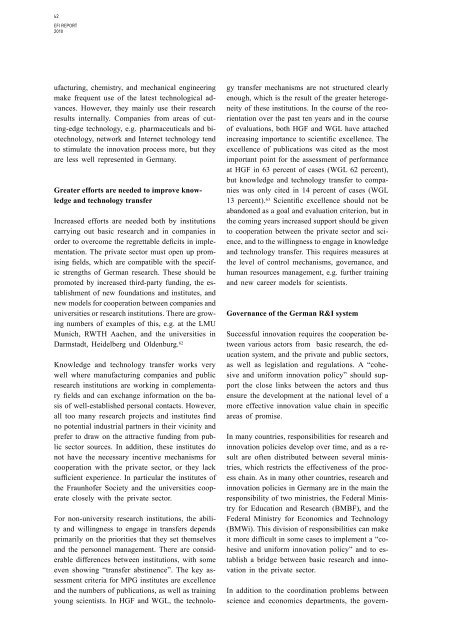
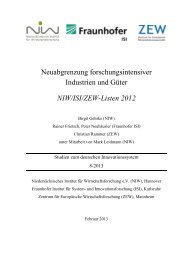



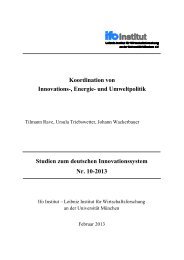

![zur Studie [Pdf, 2.574 KB] - Expertenkommission Forschung und ...](https://img.yumpu.com/20748637/1/184x260/zur-studie-pdf-2574-kb-expertenkommission-forschung-und-.jpg?quality=85)

